U.S. Cents
Large Cents, 1793‑1857
America's cent history begins in 1793, when "large cents" struck in pure copper were the first coins issued by the U.S. Mint. At the time, the value of copper was linked directly to the value of silver and gold. To give 1¢ copper coins equivalent intrinsic or metal value to silver and gold coins soon to be issued, America's first cents were nearly the size of a half dollar!
The first "large cents" were the 1793 Flowing Hair type, depicting Liberty with streaming and quite unruly hair. The original Chain Reverse – a link chain encircling the inscription ONE CENT – gave way after limited production to the Wreath Reverse, on which the chain is replaced with a wreath. From late 1793 until 1796, large cents featured the Liberty Cap design, depicting Liberty facing right with a liberty cap and pole behind her. From 1796-1807, Draped Bust large cents featured Liberty with drapery covering a plunging neckline.
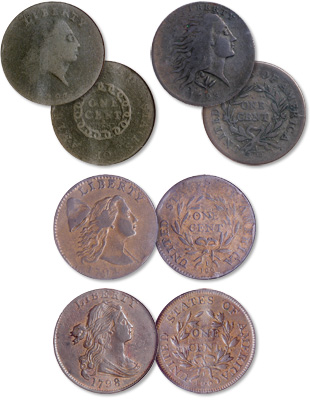
America's first large cents were the Flowing Hair with Chain Reverse and Wreath Reverse, Liberty Cap, and Draped Bust types.
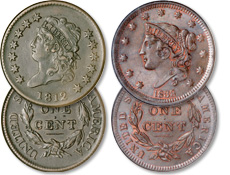
Classic Head and Liberty Head were the last large cents to be produced.
Cent history continued with 1808-1814 Classic Head large cents – on which Liberty is seen facing left, accompanied for the first time by 13 stars representing the original colonies. Due to a shortage of copper, no U.S. copper coins were struck in 1815. However, Liberty Head large cents debuted the following year and were struck until 1857. Portraying Liberty with a coronet, the Liberty Heads are often divided into the Matron Head type of 1816-1839 and Braided Hair style of 1839-1857, to acknowledge a significant change in Liberty's hair and general appearance.
Flying Eagle Cents, 1856-1858
As the price of copper rose in the 1850s, "large cents" soon cost more than a penny to produce. It was time to reduce the size of America's copper coins. About 2,000 trial "small cents" bearing a Flying Eagle design were minted in 1856 for consideration by Congress and other government officials. The reverse featured a wreath of cotton, corn, wheat and tobacco encircling the inscription ONE CENT. Struck in 88% copper and 12% nickel for the first time in cent history, the coins had a pale or "white-ish" color compared to previous pure copper large cents.
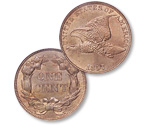
The Flying Eagle cent was minted for just two years.
Following approval of the design, the U.S. Mint issued small-size Flying Eagle cents for general circulation in 1857 and 1858. But after just two years, the Flying Eagle motif was abandoned, because the head and tail of the eagle would not strike sharply without extreme pressure. The search was on for a new design.
See our Flying Eagle cent inventory
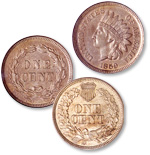
In 1860, a union shield was added to the Indian Head cent reverse.
Indian Head Cents, 1859-1909
The attractive Indian Head cent, which actually portrays Liberty wearing a Native American headdress, met with immediate favor when introduced in 1859. Issued in the same 88% copper and 12% nickel composition and designed by U.S. Mint Engraver James Longacre, the coins first featured a laurel wreath on the reverse. In 1860, the reverse design was changed to a broader wreath of oak, with the addition of a Union shield representing unity as pre-Civil War tensions increased between the North and South.
Nearly all gold and silver coins, and eventually the copper-nickel cents, disappeared from circulation during the Civil War. Privately minted bronze tokens took the place of U.S. coins, until the government stepped in with bronze Indian Head cents in April 1864 and made the issuance of private tokens illegal. These 95% copper coins with 5% tin and zinc continued through the end of the series in 1909 (copper-nickel Flying Eagle and Indian Head cents of 1857-1864 are now often referred to as "white cents" for their pale appearance).
See our Indian Head cent inventory
Lincoln Cents, 1909-Date
The Beginnings of the Lincoln Cent: The Wheat Ears Reverse
In 1908 the cent came up for redesign and Victor David Brenner was chosen by President Theodore Roosevelt to design a new cent honoring Abraham Lincoln. This original design of the Lincoln cent is known as the "Wheat Ears Reverse". It was normal at the time for U.S. coins to be inscribed with the designer's single initial, usually at the base of Liberty's neck. But Charles Barber, still chief engraver at the mint, did not wish the public to think that he, Barber, was responsible for the new design, so rather than a single B, all three of Brenner's initials V.D.B. were used and placed on the reverse. Upon the cent's release, journalists ignorant of the initials already on other U.S. coins, seized upon the V.D.B. as egotism on the designer's part. Combined with putting an actual person on a U.S. coin, the initials were regarded by some as "the first visible and outward emblem of the transmogrification of the republic into an empire" (New Orleans Picayune). The prominence of the V.D.B. was widely criticized in the media.
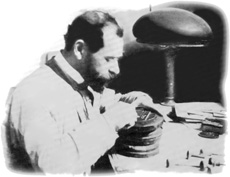
Victor David Brenner's Lincoln cent design has stood the test of time, and his Lincoln bust is one of the most reproduced works of art in the world.
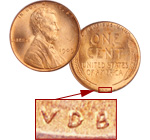
The prominence of the designer's initials, V.D.B., was widely criticized in the media.
Secretary of the Treasury Franklin MacVeagh suspended striking of Lincoln cents on August 5, 1909, after about 29 million had been struck with V.D.B.. The intent was to replace the initials with an inconspicuously placed B, but Barber objected, arguing that it would take too long to change the dies. However, he suggested, if the initials were simply removed altogether, this change could be quickly done to just the hubs, and production could be resumed within three days. With all the publicity surrounding the new cents, the revenue that would be lost by the production delay if the dies were changed, and probably in some part considering Chief Engraver Barber's personal jealousies, it was decided to just remove the initials altogether.
This change to the brand-new cents right after their release received plenty of publicity, and the hoarding of the V.D.B. cents became widespread. For this reason, many V.D.B.s have survived in higher grades. In 1918, after Barber's death, V.D.B. was restored to the cent, this time on the obverse, and barely visible to the naked eye. Victor David Brenner's design has stood the test of time, and his Lincoln bust is one of the most reproduced works of art in the world.
A Prized Collectible from the Start
No one was prepared for the level of public demand for the Lincoln cent. Banks and businesses inundated the mint with requests for the new coins. Before distribution began, the mint struck over 25 million anticipating that this would be more than enough to meet the initial demand. When the cents finally were released to the public in August 1909, people formed long lines at banks and sub-treasury offices in their eagerness to get the new coins. And, even though the distribution points limited the number available to each person, signs soon appeared to announce NO MORE LINCOLN PENNIES.
The supply of Lincoln cents ran out within three days at most locations, and this created a highly profitable market for newsboys, street sellers, and others lucky enough to purchase quantities of them. Mehl's Numismatic Monthly, a leading numismatic publication at the time, ran this story in the September 1909 issue:
In spite of the issue of about 27,000,000 of the new Lincoln cents, there was a lively run on them at the sub-treasury in New York, and newsboys in the Wall Street district did a thriving business in them. The police were needed to keep applicants for the new coin in line, and it took at least an hour of waiting to get to the window where they were issued. To prevent a monopoly, the assistant treasurer refused to issue more than $10 worth to anyone.
Rumors began to fly that the mint was going to recall the coin because of widespread hoarding. This, of course, increased demand for the coins and caused further hoarding. However, the initial hoopla over the Lincoln cent eventually calmed down. Later issues from the first decade of production weren't saved in significant quantities, and these low-mintage pieces are now hard to find.
See our Lincoln Wheat Ears cent inventory
The Memorial Reverse
The year 1959 was significant in the history of the Lincoln cent. To mark the 150th anniversary of Abe Lincoln's birth and 50th anniversary of the Lincoln series, the reverse design of the cent was changed from Wheat Ears to the Lincoln Memorial. The central seated sculpture of Lincoln in the Memorial is even seen on the coin if you look closely – making the Lincoln Memorial cent the first circulating U.S. coin to portray the same person on both sides (the 1934-1938 Daniel Boone commemorative half dollar depicts Boone on both sides).
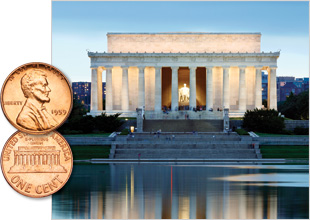
The Lincoln Memorial reverse design change of 1959 marks the 150th anniversary of Abe Lincoln's birth and the 50th anniversary of the Lincoln series.
Adding to the Lincoln cent history, the FG initials of the Memorial Reverse's designer Frank Gasparro are seen to the right of the Memorial steps on the coin. This is ironic, considering the controversy generated by Victor David Brenner's initials on the first Lincoln cents in 1909. The lowercase O in the inscription UNITED STATES OF AMERICA on the Memorial Reverse was thought to be an error. However, the same style had been used on the reverse of the Franklin half dollar.
Adding to the Lincoln cent history, the FG initials of the Memorial Reverse's designer Frank Gasparro are seen to the right of the Memorial steps on the coin. This is ironic, considering the controversy generated by Victor David Brenner's initials on the first Lincoln cents in 1909. The lowercase O in the inscription UNITED STATES OF AMERICA on the Memorial Reverse was thought to be an error. However, the same style had been used on the reverse of the Franklin half dollar.
The cent shortage of 1974
Public hoarding of cents was becoming a serious problem in 1973. The mint was having difficulty meeting demand, and concern was growing about a possible shortage of copper. In 1974, the purchasing power of the cent reached its lowest point to date, and the cent shortage became critical. Public hoarding increased when rumors flew that the cent denomination would be eliminated altogether, and again with news of the possible change to aluminum cents. Everyone wanted to save the last copper cents.
Despite production of nearly 9 billion Lincoln cents in 1974, the coins practically disappeared from general circulation, which began to disrupt the economy. The mint was working three shifts, 24 hours a day, but it was not enough to meet the Federal Reserve's needs. The mint even began experimenting with aluminum cents, but due to other difficulties these were destroyed. As an emergency measure because of the cent shortage, businesses actually began using "scrip" to make change as had been done during the Civil War and the Great Depression. This alternative usually consisted of private currency redeemable by the business who issued it.
On June 5, 1974, the mint launched a program offering a special signed citation of thanks to anyone who exchanged $25 worth of cents at their bank. The appeal to patriotism worked – by 1975, the cent shortage was over. The citizen response and record-breaking high-volume coin production at all three mints, brought things back to normal.
See our Lincoln Memorial cent inventory
The Bicentennial and Shield designs
In 2009, to celebrate both the bicentennial of Lincoln's birth, and 100 years of the Lincoln cent, the U.S. Mint issued four new reverse designs representing four major areas of the 16th president's life. Then, in 2010, the Shield Reverse was introduced to replace the Bicentennial program. Read more about these designs on our Lincoln Head Cents Design page.

The bicentennial reverse designs of 2009 depict Lincoln's Birthplace, Formative Years, Professional Life and Presidency. The Shield reverse, featuring a union shield, was introduced in 2010 to replace the long-running Memorial reverse of 1959-2008 and the special anniversary reverse designs of 2009.
See our Bicentennial Lincoln cent and Shield Lincoln cent inventory
Read more...
- Starting a Lincoln Head Cent Collection
- Articles on Cents
- Collectors Guide to Lincoln Head Cents (PDF)
- Back to U.S. Coins By Type

